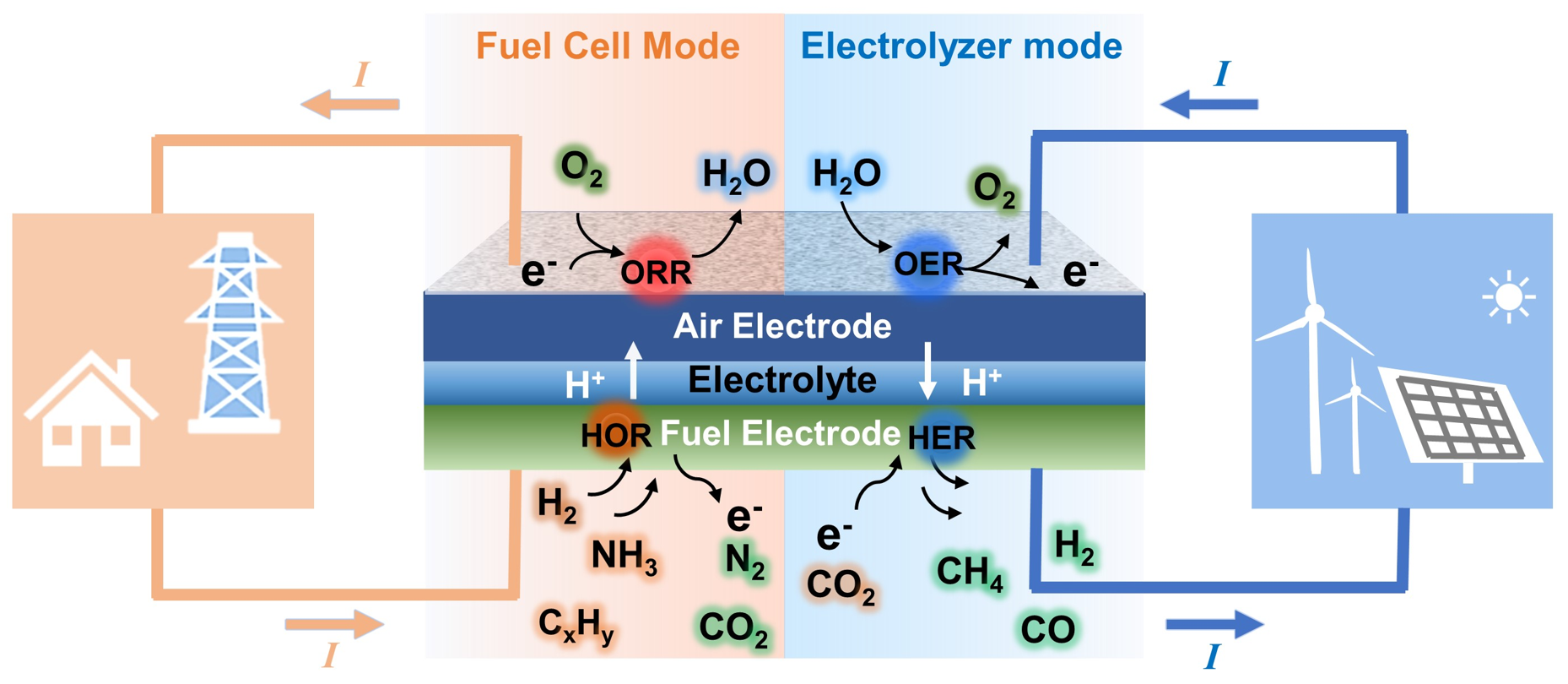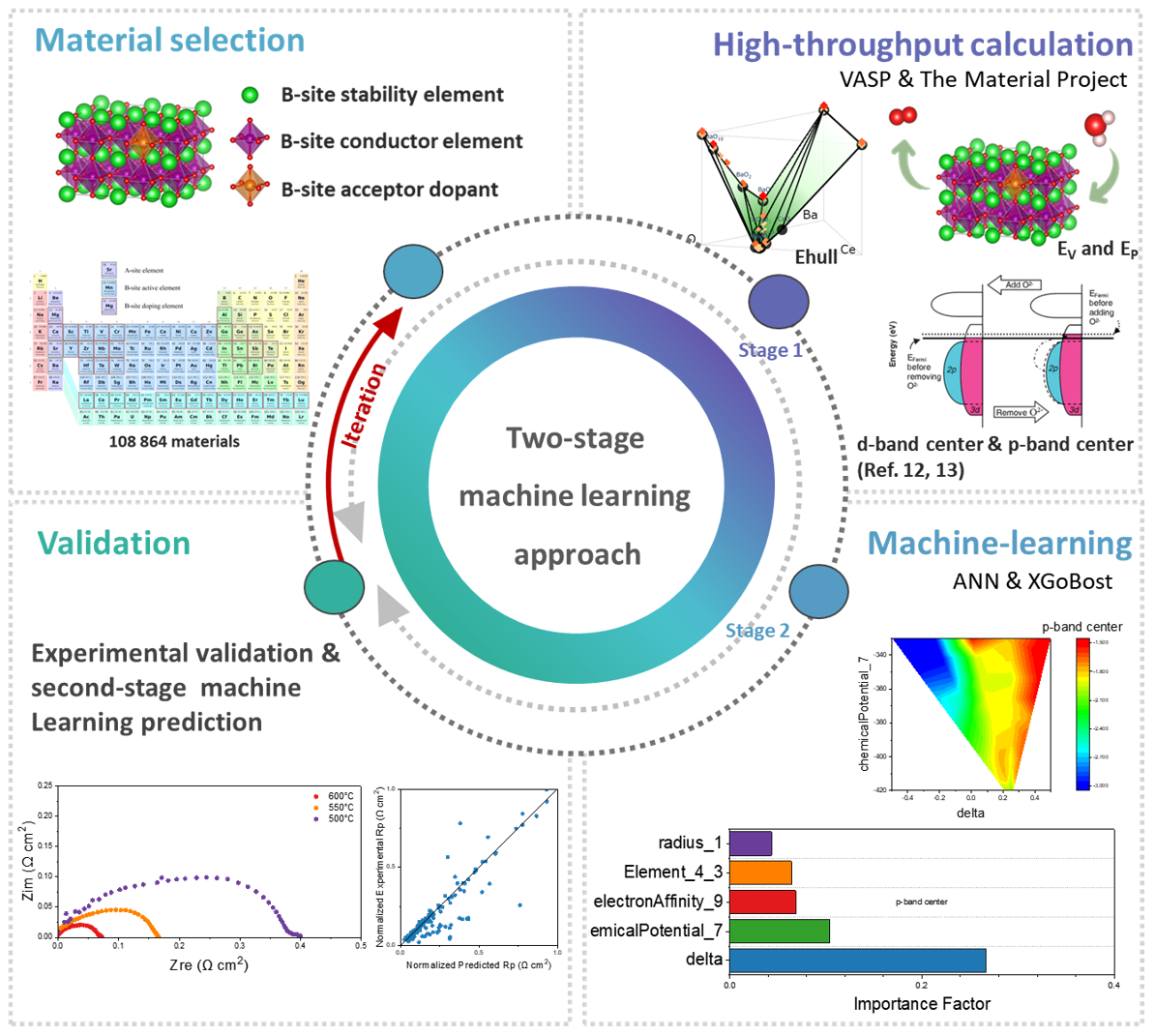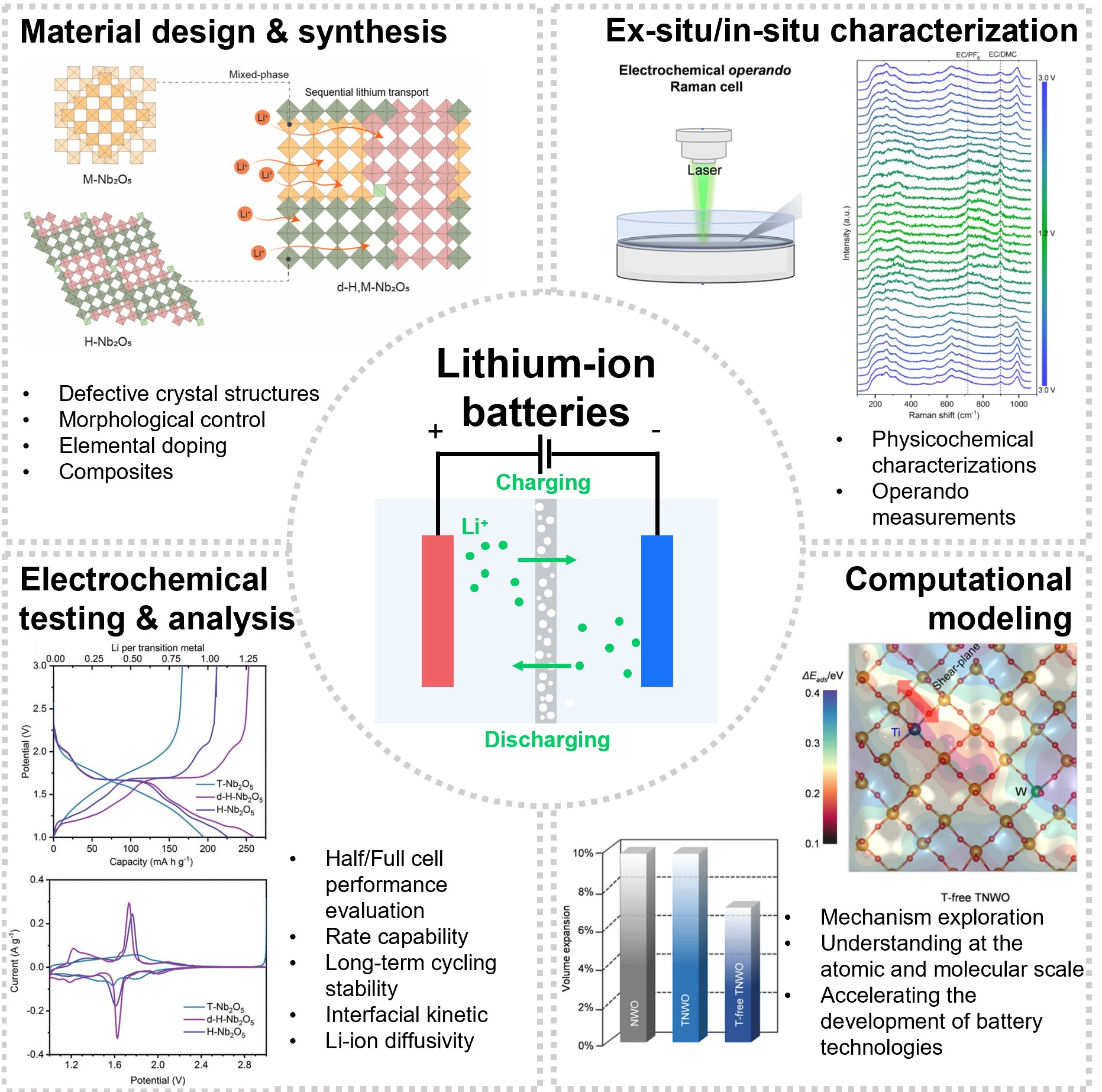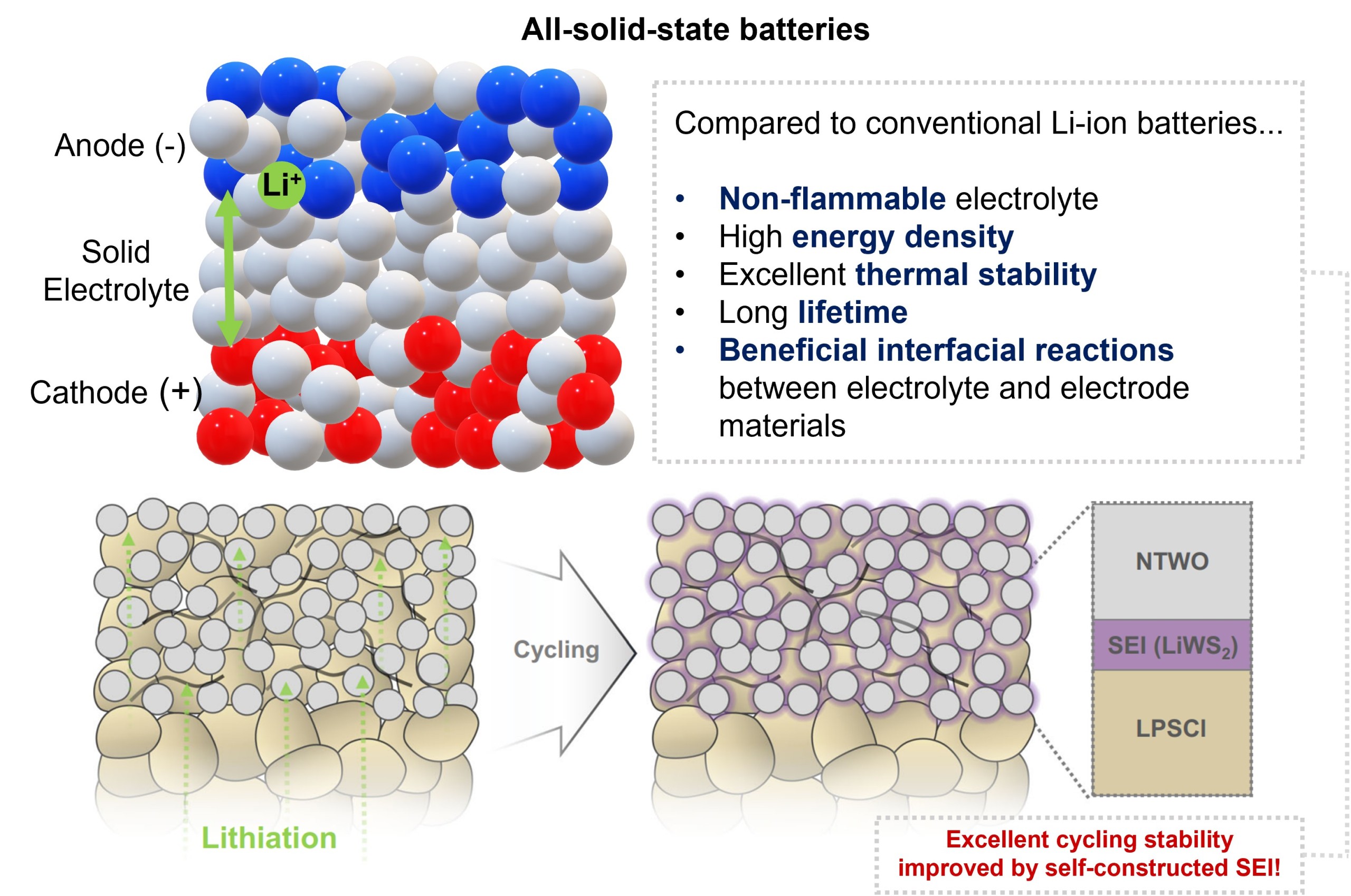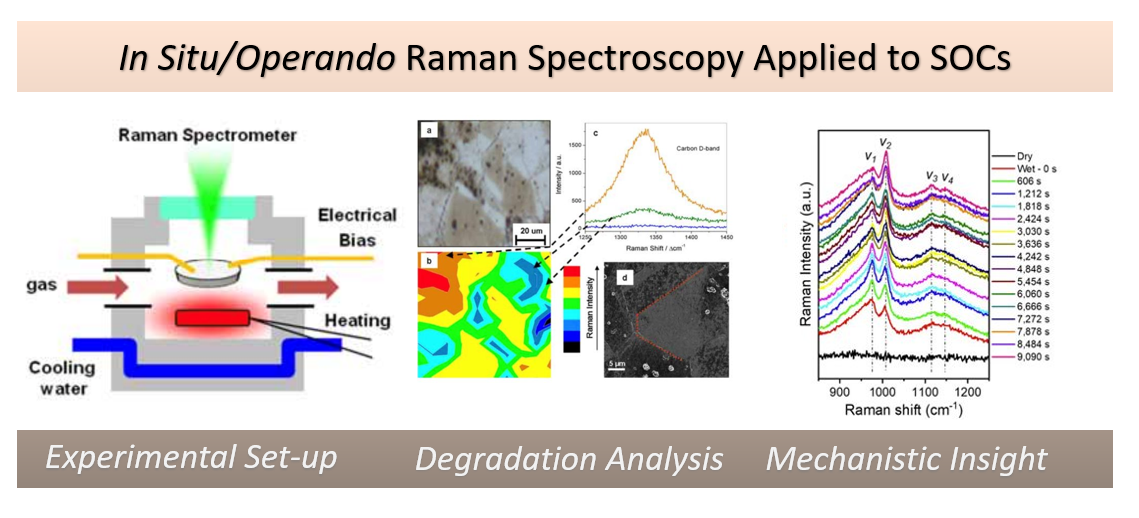RESEARCH
Exploring the role of defects and nanostructures in shaping transport and electrochemical behavior at surfaces and interfaces, while innovating new materials and architectures to advance chemical and energy transformation
Current Projects
click images to enlarge
Reversible solid oxide cells (rSOCs) for efficient energy storage and conversion
rSOCs are electrochemical cells capable of operating in two reversible modes. They function as electrolyzers to produce hydrogen or other value-added chemicals when excess green electricity from wind or solar is available. Conversely, they operate as fuel cells to convert hydrogen into electricity when needed, such as during nighttime. These cells are ideally suited for load leveling, bridging the gap between electricity production and consumption on a large scale.
Tian et al., Protonic ceramic materials for clean and sustainable energy: advantages and challenges, International Materials Reviews, 68, 272-300, 2023.
Song et al., Atomically Dispersed Ru Species Induced by Strong Metal–Support Interaction for Electrochemical Methane Reforming, JACS, 146, 31825-31835, 2024.
Zhang et al., A Synergistic Three-Phase, Triple-Conducting Air Electrode for Reversible Proton-Conducting Solid Oxide Cells, ACS Energy Letters 8 (10), 3999-4007, 2023.
Accelerating the Discovery of Novel Materials through Computation and Experimental Validation
A research paradigm integrating high-throughput calculations, machine learning, and data-driven analysis has successfully screened vast chemical spaces, identifying oxygen electrodes that significantly enhance the kinetics and durability of advanced solid oxide cells. This methodology shows great potential for driving innovations in various clean energy technologies.
Z. Luo et al., Harnessing High‐Throughput Computational Methods to Accelerate the Discovery of Optimal Proton Conductors for High‐Performance and Durable Protonic Ceramic Electrochemical Cells, Adv. Mater. 2024, 36, 2311159.
X. Hu et al., Data-driven Discovery of Electrode Materials for Protonic Ceramic Cells, Energy Environ. Sci., 2024, 17, 9335-9345
Research strategies for the development of materials for Li-ion batteries
The development of lithium-ion batteries has been driven by advancements in material design and synthesis. Ex-situ and in-situ characterization techniques and electrochemical testing have provided detailed insights into material properties and battery behavior. Additionally, computational modeling has accelerated innovation by exploring the electrochemical and structural mechanisms of the materials.
Y. Ahn et al., Mixed‐Phase Niobium Oxide as a Durable and Ultra‐Fast Charging Anode for High‐Power Lithium‐Ion Batteries, Adv. Functional Mater. 34, 231053, 2024.
T. Li et al., A niobium oxide with a shear structure and planar defects for high-power lithium ion batteries, Energy Environ. Sci. 15, 254-264, 2022.
T. Li et al., Operando Raman and DFT Analysis of (De)lithiation in Fast-Charging, Shear-Phase H-Nb2O5, ACS Energy Letters 8 (7), 3131-3140, 2023.
P. Jing et al., Tailoring the Wadsley–Roth crystallographic shear structures for high-power lithium-ion batteries – Energy Environ. Sci. 17 (18), 6571-6581, 2024.
Development of all-solid-state batteries for the next-generation energy storage
All-solid-state batteries offer significant safety advantages due to their non-flammable solid electrolytes with excellent thermal stability, eliminating the risks associated with conventional liquid electrolytes. Additionally, the solid electrolyte promotes favorable interfacial reactions with electrode materials, enhancing Li-ion transport and cycling stability.
C. Kim et al., Nb1.60Ti0.32W0.08O5−δ as negative electrode active material for durable and fast-charging all-solid-state Li-ion batteries, Nature Communications 15, 8832, 2024.
Raman Spectroscopy for Surface Analysis of Electrochemical Energy Systems
Raman spectroscopy is a powerful technique enabling in situ/operando monitoring of surface structural evolution and identification of adsorbed species leading to key conclusions about reaction and degradation mechanisms in battery and fuel cell components. Unlike conventional electron microscopy and spectroscopy techniques, Raman spectroscopy does not require high vacuum to function and offers great versatility in the types of atmospheres that can be introduced into the testing environment, giving rise to unique insights into the reaction processes occurring at the involved surfaces and interfaces.
T. Li et al., Operando Raman and DFT Analysis of (De)lithiation in Fast-Charging, Shear-Phase H-Nb2O5, ACS Energy Letters 8 (7), 3131-3140, 2023.
X. Li et al., In situ and surface-enhanced Raman spectroscopy study of electrode materials in solid oxide fuel cells, Electrochem. Energ. Rev. 1, 433–459, 2018.
D. Chen et al., Unraveling the Nature of Anomalously Fast Energy Storage in T-Nb2O5, JACS 139 (20), 7071-7081, 2017.
Prior Grants and Contracts
New Materials for Efficient Energy Conversion and Storage (Phillips 66, 1/2022-12/2024)
Tuning structure and oxygen defects of M-Nb2O5-x for high performance lithium-ion batteries (CBMM, 8/2021-7/2024)
Durable and High-Performance SOECs Based on Proton Conductors for Hydrogen Production (DOE, DE-FE0032115, 9/2021–5/2024)
Reversible fuel cells for co-generation of hydrogen and power (DOE through Phillips 66, DE-FE0031975, 9/2021–2/2024)
Man-portable, direct-fuel capable, tubular solid oxide fuel cell (ARL through MillenniTek, Phase 2.2, 9/2021-9/2023)
Effect of Doping/Nanostructuring on Properties of perovskite catalysts for OER (NSF DMR-1742828, 8/2017-7/2023)
Durable, High-Performance Unitized Reversible Fuel Cells Based on Proton Conductors (DOE EERE, 10/2018-3/2022)
Man-portable, direct-fuel capable, tubular solid oxide fuel cell (ARL through MillenniTek, Phase 2, 10/2020-9/2022)
T-Nb2O5-based film electrode for next-generation ultrafast batteries (CBMM, Brazil, 11/2019-12/2022)
Rational Design of PGM-free Catalyst for PEMFCs (Hyundai, 11/2019-4/2021)
high-performance intermediate-temperature SOFCs (Nissan Technical Centre, 4/2018-3/2021)
Highly-Active and Contaminant-Tolerant Cathodes for Durable SOFCs (DOE Fossil Energy, 10/2017-9/2019)
Development of High-Performance SOFC Materials (Phillips 66, 1/2019-12/2021)
Freeze Casting of tubular solid oxide fuel cells (ARL through MillenniTek LLC, 5/2018-4/2020)
Development of Tubular Solid Oxide Fuel Cells (ARL through MillenniTek, 10/2017-9/2019)
Development of cost competitive MEAs for high-performance PEM fuel cells (Kolon Industries, 3/2017-6/2019)
Investigation into surface-modified electrode materials for Li-ion batteries (NSF, 7/2014-6/2018)
A Novel Intermediate-Temperature Fuel Cell Tailored for Efficient Utilization of Methane (DOE ARPA-E, 10/2014-2/2018)
Design and Fabrication of MIEC Membranes for Oxygen Separation (DOE through HiFunda, 10/2015-9/2017)
Low-Cost, Durable, Contaminant-Tolerant Cathodes for SOFCs (DOE-SECA, 10/2015-6/2017 )
Novel Electrodes with High Ionic/Electronic Conductivity for Fuel Cells with Dynamic Response Capability (ARPA-E, 10/2014-9/2016)
Ultra-high Performance Supercapacitors using Tailored Molecular Spacers (ARPA-E, 5/2013-4/2016)
Rational Design of Durable High-Performance Cathodes (DOE-SECA, Core Technology Program, 10/2012-9/2015)
Science Based Nano-Structure Design and Synthesis of Heterogeneous Functional Materials for Energy Systems (DOE-BES, EFRC, 10/2009-7/2015)
Battery Powered Oxygen Generators (DOD through HiFunda, 2015-2016)
Fabrication and Testing of Solid Oxide Fuel Cells (1806K44) (ARL through MillenniTek, 2015)
Fundamental Study of Sulfur-Tolerant Anodes for TOPSOE Cells (Topsoe Fuel Cells, 3/2011-8/2014)
Modeling, Simulation, and Characterization of Hydrogen Permeable Membranes (Samsung Advanced Institute of Technology, 10/2010-8/2014)
Novel Materials for Low Temperature Solid Oxide Fuel Cells (ConocoPhillips, 5/2010-4/2013)
Development of Pd-based membranes for hydrogen separation with sulfur/carbon tolerance, (DoE through Pall Corporation, 6/2011-6/2012)
Theory, Investigation, and Stability of Cathode Electrocatalytic Activity (DOE-SECA Core Technology Program, 2008-2012)
Understanding the Interfacial Structure-Chemistry Relationships in Solid Oxide Fuel Cells (DOE-BES, 10/2006-9/2010
Characterization of Atomic and Electronic Structure of Electrochemically Active SOFC Cathode Surfaces (DOE-UCR, 3/2006-8/2009)
Sulfur-Tolerant Anodes for SOFCs (DoE-SECA Core Technology Program, 2005-2009)
Proton Electrolyte Membranes for Fuel Cells (Toyota, 2003-2008)
Functionally Graded Cathodes for Solid Oxide Fuel Cells (DOE-SECA Core Technology Program, 2002-2008)
NSF Industry/University Corporative Research Center – Fuel Cells (NSF, 2005-2008)
Novel Electrolyte Membranes for a New Generation of SOFCs (Nissan Motor Company, 2005-2008)
Advanced Fuel Cells for Aerospace Power Generation (NASA-URETI, with Dr. Parekh of GTRI, 2002-2007)
Quantitative Characterization of Cr Poisoning of Cathode Activity (DOE-SECA Core Technology Program, 2006-2007)
Probing and Mapping Interracial Reactions in SOFCs Using Raman spectroscopy, FTIR Emission Spectroscopy, Impedance Spectroscopy, and Mass Spectrometry (DURIP/ARO)
Nanostructured Composite Electrodes for Lithium Batteries (DOE-BES, with Dr. J. Gole of Physics)
Hybrid Metal/Electrolyte Monolithic Low-Temperature Solid Oxide Fuel Cells (DARPA/DSO, Palm Power Program, with Drs. J. Cochran, J. Lee, D. McDowell, and T. Sanders)
Novel Materials for Low-Temperature SOFCs (DOE, University Coal Program)
Cathode Materials for Lithium-ion Batteries (Samsung)
Nanostructured Solid-State Power Capacitors (MicroCoating Technologies/Navy)
SOFCs Powered by Sour Natural Gas (Shell Chemical)
Solid Oxide Fuel Cells Using H2S as Fuel (NSF, with Dr. J. Winnick of Ch.E.)
Development of Ceramic Membranes for Hydrogen Separation (ANL)
Novel Solid Oxide Fuel Cell Systems (Reactive Energy)
Nanostructured Porous Electrodes Fabricated by CCVD (DOE through MicroCoating Technologies)
Development of Electrodes for H2S removal (ONR, with Dr. J. Winnick of Ch.E.)
Preparation of Transparent Conducting Coatings (Symphonic Optical Technologies, Inc.)
Preparation and Characterization of Mesoporous Eletrodes for Solid State Ionic Devices (NSF, Division of Chemical &Transport Systems)
Preparation of Transparent Conducting Metal Oxide Coatings Using a Sol-Gel Peocess (Gazillion Bits, Inc.)
Advanced Electrode Materials for Lithium Batteries (American Chemical Society – PRF)
Modeling and Design of Mixed-Conducting Electrodes for SOFCs (ORNL)
NSF Young Investigator Award (NSF-DMR, 1993-1998)
Ceramic Membranes for Methane Conversion and SOFCs (NSF, Division of Chemical &Transport Systems)
All-Solid-State Lithium Batteries (Caleb)
High-Selectivity Gas Sensors (NASA – Lewis Research Center)
Outstanding Faculty Research Author Award (GTRC)
Thin-Film Oxygen Sensors (Engelhard)
Focused Research Program in Nanostructured Materials for Electrochemical and Catalytic Applications, GTRC, M. Liu (PI), L. Bottomley, W. Rees, A. Saxena, N. Thadhani, Z. L. Wang, M. White, and J. Winnick.
Development of BaCeO3 Based Materials for Intermediate-Temperature Solid Oxide Fuel Cells (EPRI)
Synthesis, processing , & characterization of ceramic membranes for hydrogen separation (ANL)
Development of Rubbery Electrolytes for Thin-Film Batteries (NASA – Jet Propulsion Laboratory)
Development of Mixed-Conducting Ceramic Membranes (Ceramatec)
Interdisciplinary Research on Chemical Sensors, GTRC, M. Liu (PI) and M. White (Co-PI)
Multifunctional Sensors for Combustion Control (GRI)
Mixed Conductors for Oxygen Separation (GRI and EPRI)
Electrochemical Removal of NOx from Engine Exhaust Using Ceramic Catalysts (DoE and Cummins Engine Company)
Salt-Splitting Using Ceramic Membranes (Eka Nobel Chemicals)
Process Development of Prototype Oxygen-Separation Devices Based on Mixed-Conductor Tubes (GRI)
Thermoelectric Generators Based on Solid Electrolytes (ONR through University of Utah)
Sodium Sensors Based on Ceramic Membranes (Elkem)
